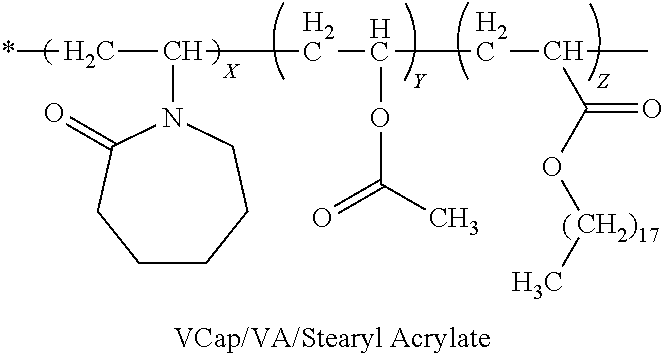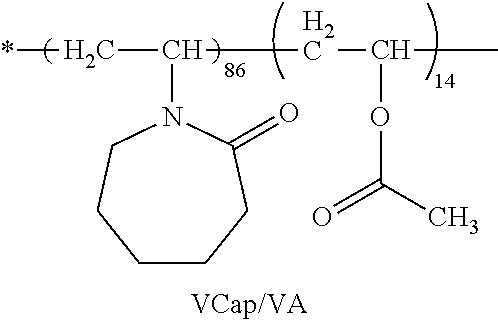Coating compositions for forming toner coatings
a technology of coating composition and coating layer, which is applied in the direction of instruments, optics, developers, etc., can solve the problems that the print quality, integrity, and adhesion of paper substrates have not been achieved for printing onto plastic substrates such as vinyl, polyester and polyolefin
- Summary
- Abstract
- Description
- Claims
- Application Information
AI Technical Summary
Benefits of technology
Problems solved by technology
Method used
Image
Examples
example 1
VCap / VA / Stearyl Acrylate (50 / 40 / 10)
[0054]
[0055]Feed one is prepared with 57.43 g vinyl caprolactam (VCap) (dissolved in 42.37 g MEK); and 26.82 g stearyl acrylate. Put 158.91 g MEK and 28.45 g vinyl acetate (VA) into the reactor and commence purging of the reaction vessel with nitrogen. Heat the reaction flask containing MEK and VA to reflux ˜78° C. In a separate vessel prepare a mixture of Triganox 25 C 75 (0.5 g) and MEK (21.18 g). Label this vessel “Triganox Solution”. When the reaction flask has reached reflux temperature, begin adding Feed 1, drop-wise, in to the reaction vessel over a period of 180 minutes. After 15 minutes of monomer feed, add 2 g of the Triganox Solution into the reactor. Continue the drop-wise addition of Feed 1 over a period of approximately 165 minutes. While the monomers are feeding into the reactor, after 30 minutes charge 2.17 g of the Triganox solution. After 45, 60, 75, 90, 105 and 120 minutes, charge 2.17 g Triganox solution into the reactor. After ...
example 2
VCap / VA (86 / 14) Co-Polymer
[0056]
[0057]In a flask equipped with a stir bar, condenser, thermocouple and nitrogen purge place 230.29 g ethanol. Purge the solvent with nitrogen over 20 minutes. Heat the solvent to reflux. The following monomer feeds are prepared: monomer Feed 1 is 10.00 g Vinyl acetate; monomer Feed 2 is 87.00 g Vinyl caprolactam. Feed 1 is added to the reaction, drop-wise over 60 minutes (concurrently with Feed 2). Feed 2 is added to the reaction, drop-wise over 120 minutes (concurrently with Feed 1). In a separate vessel, a mixture of 1.0 g of Trigonox 25 C 75 and 5.0 g of ethanol is prepared and is labeled as “Initiator Solution”. After Feeds 1 and 2 have been adding for 10 minutes, add 1.0 g of the Initiator Solution to the reaction vessel. Continue the drop-wise addition of Feeds 1 and 2 to the reaction vessel. After 30 minutes of monomer feed, charge 1.0 g of the initiator solution to the reaction vessel. After 60 minutes of monomer feed, charge 1.0 g of the init...
example 3
Ink Adhesion on Primer-Coated Clear Polyester
Testing Procedure
Method 1
Preparation of Ink Film and Ink Strips
[0058]HP Electroink Black was transferred entirely to a plastic container. This ink was folded repeatedly with a spatula by mixing the suspended ink particulates to a homogeneous ink paste.
[0059]The ink paste mentioned in Step A1 (20.0 g) and HP Imaging oil (10.0 g) were added to a 60 ml screw-capped glass vial and mixed well by vigorous shaking to obtain a sample of diluted ink suspension.
[0060]Non-Corona treated surface of Clear Polyester film (5 mil, 8.5 inch×1 linch) was coated with the sample of diluted ink suspension obtained in Step A2 by drawing down a thin ink film on the Clear polyester surface using Meyer Coating Rod #26. The wet ink film obtained was allowed to sit on a flat surface for 10 min at room temperature.
[0061]The ink film on Clear polyester thus obtained in Step A3 was further dried under vacuum at 100° C. for 20 min in a vacuum oven and then cooled to ro...
PUM
| Property | Measurement | Unit |
|---|---|---|
| temperatures | aaaaa | aaaaa |
| temperatures | aaaaa | aaaaa |
| charge | aaaaa | aaaaa |
Abstract
Description
Claims
Application Information
 Login to View More
Login to View More - R&D
- Intellectual Property
- Life Sciences
- Materials
- Tech Scout
- Unparalleled Data Quality
- Higher Quality Content
- 60% Fewer Hallucinations
Browse by: Latest US Patents, China's latest patents, Technical Efficacy Thesaurus, Application Domain, Technology Topic, Popular Technical Reports.
© 2025 PatSnap. All rights reserved.Legal|Privacy policy|Modern Slavery Act Transparency Statement|Sitemap|About US| Contact US: help@patsnap.com


